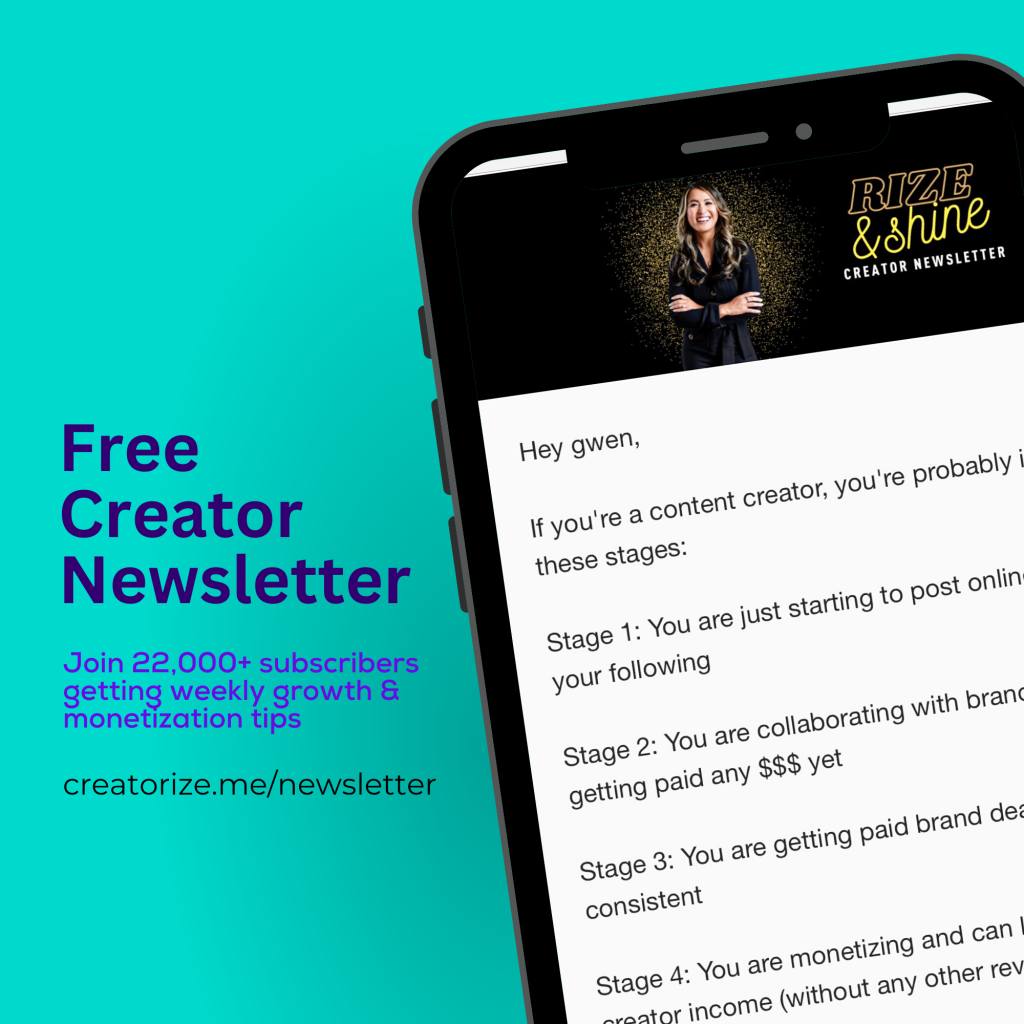Aspiring to become a user-generated content creator in today’s digital landscape? This article will provide a thorough overview of the steps and tactics needed to become an effective UGC creator in today’s digital environment. User-generated content (UGC) has transformed the way brands engage with their audience, making it an essential component of modern marketing campaigns.
In this post, we’ll explore how UGC has impacted the way brands interact with their audiences and its significance in contemporary marketing strategies. We’ll also discuss how to create engaging content by identifying your niche market and incorporating trends. You’ll learn about the differences between UGC and brand deals, as well as charging fees that reflect your value as a creator.
Furthermore, we will explore leveraging user-generated content for businesses using tools to manage and aggregate UGC while increasing audience engagement. Finally, building your portfolio as a UGC creator is crucial; hence we’ll cover the importance of having an online presence and showcasing past work along with setting goals for video projects that align with client expectations.
Embark on this journey to discover how to become a user-generated content creator who excels in today’s competitive digital world!
Table of Contents:
- Understanding User-Generated Content
- Types of User-Generated Content
- The Role of UGC in Marketing
- Finding Your Niche as a UGC Creator
- Pricing Strategies for UGC Creators
- Utilizing Tools for UGC Management
- Building a Credible Portfolio
- Setting Goals & Achieving Success
- FAQs in Relation to How to Become a User-Generated Content Creator
- Conclusion
Understanding User-Generated Content
User-generated content (UGC) refers to any content created by users or customers rather than brands themselves. This kind of content has grown in prevalence, as it furnishes a more real and pertinent viewpoint on goods and services. Some common examples of UGC include TikTok videos featuring a product, Instagram stories with tagged brands, and customer reviews on websites like Yelp.
Types of User-Generated Content
- Social media posts: Photos, videos, or text shared on platforms like Instagram, Twitter, Facebook, etc.
- Videos: Product reviews or tutorials uploaded to YouTube or TikTok.
- Blog articles: Personal experiences or opinions written about specific businesses/products/services.
- Reviews & testimonials: Customer feedback provided through review sites such as Yelp or Google Reviews.
The Role of UGC in Marketing
In today’s digital landscape, user-generated content plays a crucial role in marketing strategies for many businesses. A study conducted by Stackla revealed that consumers find UGC to be 9.8 times more impactful than influencer-created branded content when making purchasing decisions.
This highlights the importance for companies to leverage user-generated material alongside their traditional advertising efforts. By incorporating genuine customer experiences into their promotional campaigns, businesses can build trust with potential buyers, encourage engagement from their audience, and ultimately drive sales.
Finding Your Niche as a UGC Creator
To become a successful user-generated content creator, it’s crucial to choose an area you’re passionate about and create engaging content around it. Identifying your strengths and interests within the market where you can excel and thrive is essential for long-term success.
Identifying Your Passion Points
Compile a list of topics that fascinate you or domains in which you have proficiency. Consider hobbies, personal experiences, or industry knowledge that could translate into captivating content for your audience. Once you’ve identified potential niches, research their popularity on various platforms like Google Trends, Instagram hashtags, or YouTube search results to gauge demand.
Researching Existing Creators for Inspiration
Analyze other creators within your chosen niche to identify what works well and opportunities for differentiation. Pay attention to the types of content they produce, engagement levels from their audience, and any gaps in coverage that could be filled with unique insights or perspectives. You can use tools like Socialbakers or BuzzSumo to find popular creators within specific niches.
Strategizing with these techniques can assist in building your authority as a professional within the sector, while also offering valuable content generated by users that appeals to viewers and businesses.
Incorporating Trends into Your Content
Keeping up with popular trends on platforms like TikTok and Instagram is essential for making your user-generated content more captivating to your audience. By incorporating trending elements into your unique creations, you increase the chances of being discovered by potential clients.
Staying Updated on Platform-Specific Trends
To stay updated on platform-specific trends, follow popular creators in your niche and observe the type of content they are producing. You can also use tools like Google Trends, which helps identify trending topics across various categories. Additionally, join online communities or forums where fellow UGC creators discuss emerging trends and share insights.
Balancing Originality with Trendiness
Incorporating current trends should not compromise the originality of your content. Strive to strike a balance between following popular themes while maintaining authenticity that reflects your personal brand identity. For example, if there’s a viral dance challenge going around TikTok but dancing isn’t part of your niche or expertise, find creative ways to adapt the trend to suit your style instead.
A successful approach involves combining trendy aspects with fresh ideas that showcase both creativity and relevance within the ever-changing digital landscape. This will help you stand out among other UGC creators while simultaneously attracting attention from brands looking for innovative partnerships.
Approaching Brands and Expanding Your Client Pool
To become a successful user-generated content creator, it is essential to proactively approach brands and expand your client pool. Start by researching potential clients’ existing marketing strategies and identifying gaps where you could add value through user-generated content. For instance, if you notice that a brand lacks engaging video content on their social media channels, this could be an opportunity for collaboration.
Freelance platforms can also provide opportunities to connect with businesses seeking UGC creators. Platforms like Upwork or Fiverr allow you to showcase your skills and pitch directly to companies in need of content creation services.
Analyzing Brand Strategies
Prioritize the analysis of brand strategies before approaching them for collaborations or partnerships. Understand their target audience, tone of voice, visual aesthetics, and overall messaging goals. This will enable you to tailor your pitch effectively while demonstrating how your unique style aligns with their objectives.
Leveraging Freelance Platforms
In addition to reaching out directly to brands within your niche, consider leveraging freelance platforms such as Upwork, Fiverr, or even specialized networks like IZEA xChange. These sites offer numerous opportunities for UGC creators looking for paid projects while simultaneously expanding visibility among potential clients searching for creative talent.
Pricing Strategies for UGC Creators
As a user-generated content (UGC) creator, it’s important to establish appropriate fees for your services. The pricing may vary based on factors such as your reputation, audience size, content quality, and scope. A common formula involves multiplying the time spent creating content by an hourly rate reflecting engagement levels. On average, charges were found to be $520 per project, but this might differ according to individual circumstances.
Factors Affecting Pricing
When determining your rates, it’s important to consider aspects like your niche expertise, target audience demographics, platform-specific metrics (e.g., impressions or reach), and the level of customization required by clients. Additionally, it’s essential to research industry standards within your niche to ensure competitive pricing while maintaining profitability.
Calculating Your Hourly Rate
To calculate an accurate hourly rate for your services as a freelance UGC creator, consider factors such as your experience level and desired income goals. Here’s how:
- Analyze similar creators’ rates in your niche for reference points.
- Determine the number of hours you’re willing to work weekly and multiply that by weeks worked annually.
- Add up all business expenses (equipment costs, software subscriptions) then divide this total amount by annual billable hours from step two.
- Add a profit margin percentage on top of calculated expenses per hour – this becomes your final hourly rate.
Note that adjusting prices over time is necessary due to changes in market conditions or personal growth within the industry. Always stay informed about trends and adapt accordingly.
Utilizing Tools for UGC Management
As a user-generated content creator, it’s important to stay organized and consistent in your posting schedule to maximize engagement. Fortunately, there are various tools available that can help streamline the process of managing and sharing your content across different platforms.
Scheduling Tools for Consistent Posting
Later’s management platform is an excellent tool for scheduling social media posts on platforms like Instagram, Facebook, Twitter, and Pinterest. By planning your posts ahead of time with Later, you can ensure consistency in your content release schedule while also freeing up more time to focus on creating new material. Other popular scheduling tools include Buffer and Hootsuite.
Aggregating UGC with Specialized Platforms
In addition to staying organized with post scheduling, it’s essential to keep track of user-generated content featuring your brand or products from other users. Platforms such as EmbedSocial and Taggbox help aggregate user-generated content from major networks like Instagram, Twitter, Facebook, YouTube, and TikTok. By using these aggregation tools, you can increase the chances of impacting viewers by up to 70% better than other methods, since potential clients will see how others interact positively with what you offer.
By leveraging these powerful tools, user-generated content creators can maintain a strong online presence, enabling them not only to reach wider audiences but also to attract lucrative partnerships. Together, Later’s management platform along with EmbedSocial or Taggbox can significantly improve your workflow and increase the overall effectiveness of your UGC strategy.
Building a UGCPortfolio
To establish credibility and demonstrate expertise, a strong portfolio is key in the user-generated content realm. This allows potential clients to measure the value you can bring before investing in partnerships or collaborations. A well-crafted portfolio should include examples of previous work, client testimonials, and any relevant achievements.
Importance of a Strong Portfolio
A strong portfolio not only demonstrates your skills as a UGC creator but also helps build trust with prospective clients. It serves as proof that you have successfully executed projects in the past and are capable of delivering high-quality content tailored to their needs. Additionally, an impressive portfolio sets you apart from competitors vying for similar opportunities.
Case Studies of Successful UGC Creators
- DeAndre Brown: DeAndre is known for creating comedic Gen-Z life videos on TikTok which led him to collaborate with major brands like Nike and Coca-Cola. His engaging content showcases his unique perspective while promoting products seamlessly within his videos.
- Kiehl’s Collaboration: When skincare brand Kiehl’s partnered with several Instagram creators, they leveraged their influencers’ personal experiences using Kiehl’s products through authentic storytelling. The result was highly relatable user-generated content that resonated with their target audience.
To make an impressive portfolio, create top-notch examples that showcase your imagination and capacity to engage with viewers across different media such as social networking sites, blogs, and discussion boards. This will ultimately lead to more monetization opportunities and long-term success as a UGC creator.
Setting Goals & Achieving Success
Aligning your personal objectives with those of brands and clients will help you create captivating material that benefits both parties.
Aligning Personal Objectives with Client Expectations
Before starting any collaboration, discuss the expectations and desired outcomes with your client. This ensures that everyone is on the same page regarding content direction and messaging. For example, if you’re working on a user-generated content (UGC) campaign, make sure to understand the brand’s target audience, tone of voice, and overall marketing strategy.
Strategies for Long-Term Success
- Consistency: Maintain a regular posting schedule across all platforms to keep your audience engaged and attract new followers.
- Diversification: Explore different types of content (e.g., blog posts, podcasts) or expand into other niches within your area of expertise to broaden your reach.
- Cultivate Relationships: Build strong connections with fellow creators through collaborations or networking events like VidCon.
- Analyze Performance Metrics: Regularly review analytics data from platforms such as YouTube Analytics or Instagram Insights to identify trends in engagement levels and adjust strategies accordingly.
Incorporating these strategies into your UGC creation process requires passion, dedication, commitment, and the ability to produce engaging material consistently. By sharing captivating content on online platforms, blogs, and forums alike, you can create monetization opportunities and achieve success as a UGC creator.
FAQs in Relation to How to Become a User-Generated Content Creator
How to Become a User-Generated Content Creator
To become a user-generated content (UGC) creator, you need to identify your niche and create engaging content on social media platforms. Focus on authenticity, incorporate trends, and leverage user-generated content for businesses. Build an online presence, showcase past work in a portfolio, set goals for projects, and track progress to measure success.
Getting Started with User-Generated Content
Begin by choosing the right platform(s) for your target audience and niche. Research popular trends within your industry or interest area. Create original and authentic content that resonates with viewers while incorporating these trends when appropriate. Engage with your audience through comments or collaborations to build rapport.
Becoming a UGC Creator in 2023
Stay updated on emerging social media platforms as well as new features of existing ones. Adapt quickly to changes in algorithms or trending topics while maintaining consistent posting schedules across chosen channels. Network with other creators for collaboration opportunities and continue refining skills like video editing or storytelling techniques.
How Much Does UGC Pay?
UGC payment varies based on factors such as experience level, follower count, engagement rates, niche market demand, and project complexity. Smaller creators may charge $50-$500 per post while larger influencers can earn thousands per campaign. Set rates reflecting value provided and negotiate accordingly.
Conclusion
Generating content from users can be a successful approach to developing your online presence and broadening your reach. To become a successful creator, you need to identify your niche market, incorporate trends into your content, set appropriate rates, leverage UGC for businesses, build a portfolio, and track progress.
If you’re interested in becoming a user-generated content creator or want to improve the quality of your work, check out CREATORIZE a platform that provides creators with tools and resources to help them grow and monetize their brand.





